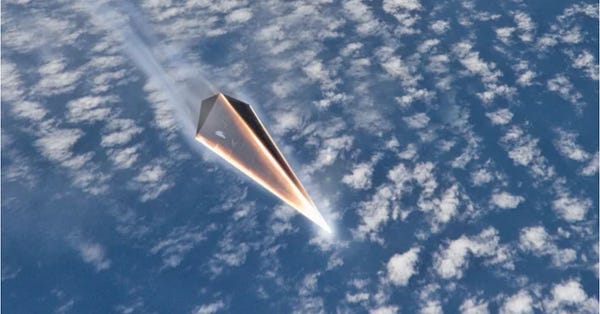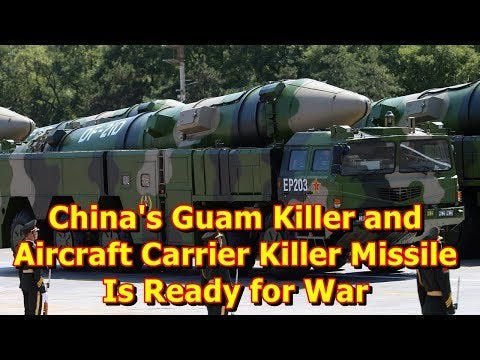On December 7, 1941, the Japanese bombed Pearl Harbor and destroyed a large portion of the American Pacific Fleet. It is billed in history as a surprise attack. In terms of location and means of execution that is true. That a war with Japan was impending at some point and that the Japanese were likely to initiate hostilities, however, was well known and had been anticipated for years. Indeed, the U.S. Navy had long before the attack on Pearl Harbor crafted War Plan Orange pursuant to which we would fight and win a war in the Pacific against Imperial Japan.
What happened on December 7th was in essence a failure of imagination. We failed to consider the possibility that the war would begin with an attack so audacious and so devastating. We were caught preparing for one war. The enemy decided to fight another.
If we are not careful the same thing will happen to us in a future conflict with Communist China.
For some time now the Chinese have been launching missiles at targets in the Takmalakan desert that mimic the outlines of American nuclear aircraft carriers. Now, it has been reported that a series of different targets have appeared at a string of missile ranges along the eastern edge of the same desert. Several of these targets mimic ships in port.
Eight miles southwest of an existing aircraft carrier layout a new target with full-scale piers and a destroyer-sized ship-like target was constructed in December. A test missile hit ‘dead center’ on the ship replica in February.
Another similar naval base target was found about 190 miles away. This target was apparently built in December 2018, but had escaped notice until now. The pier layout is similar to the destroyer-like site, and it also includes ship targets, with one in the same place as the latest target. The nature of the targets and the tests being conducted suggest strongly that the Chinese are testing the use of anti-ship ballistic missiles (ASBMs) for use in attacks on American and allied forces.
The Chinese have a number of types of ASBM’s including a new weapon, which can be launched from Chinese naval vessels. Modern ‘dumb’ ballistic missiles are remarkably accurate but still have a significant chance of missing a ship ‘at dock’ by enough to allow the target to survive. The testing underway suggests that the Chinese may be working on the integration of infrared, optics, and radar into their missiles to allow for precise targeting. This would mean that the Chinese would have in effect a one shot one kill capability to utilize against all American Navy vessels that could be identified and located. Those sitting in port would obviously be most vulnerable.


As the Chinese work on these elements of their strike capability, they are also enhancing their lethality in other ways. The YJ-21 ship-launched ballistic missile for example carries a hypersonic glide vehicle. This means the missile launches almost straight up and then glides into its target at hypersonic speeds making it extremely difficult to intercept and shoot down.


China’s DF-26 intermediate-range ballistic missile has a range of 3400 miles. That means it can be launched from mainland China and reach a number of American military installations including the increasingly important bases on Guam. The Chinese, in fact, refer to the DF-26 as the “Guam Killer”, which in the intelligence business they call a “clue.”


All of this is being combined with an unprecedented buildup in Chinese space-based intelligence, surveillance, and reconnaissance capabilities. China now operates more than 250 spy satellites – more than any other nation other than the United States. This means the Chinese know precisely where all American military assets are at any time and can strike with precision and largely without warning if they so choose.
There is considerable discussion these days about the possibility of a Chinese move to invade Taiwan and return what it regards as a breakaway province to the fold. Much of the focus is on building up Taiwanese defense capabilities and figuring out how the United States should and could respond to such an assault.
All of that is important, but perhaps we ought to consider the possibility that an assault on Taiwan would begin not with an attempt to neutralize the defenses of that island nation but with an overwhelming surprise attack on American forces in the Pacific. Rather than wait for the 7th Fleet to come to the rescue and then attempt to destroy the U.S. Navy at sea, perhaps the CCP might begin the conflict from an almost cold start with a strike on U.S. bases, U.S. carrier battle groups, and U.S. Marine Corps installations.
Then, as we attempted to sort through the wreckage and figure out just how fast we can build new aircraft carriers to replace the ones we just lost, the Chinese would move against our allies in the region who would be left largely to fend for themselves.
We were surprised once over eighty years ago by the boldness of our enemy. It might be a good idea to avoid allowing that to happen again.
One Pearl Harbor is enough.



